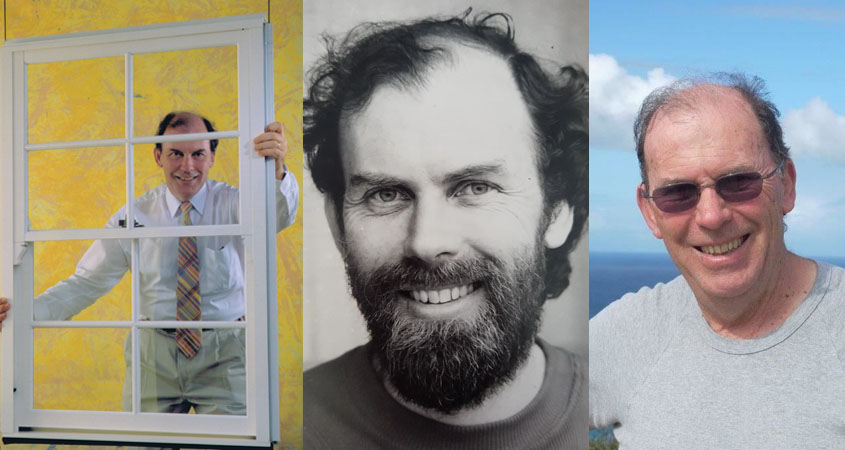
Emeritus Professor John Ballinger, B. Arch (Hons. Adelaide), AM, FRAIA
John was awarded the honour of Institute Fellowship in 1978.
Fellowship is awarded to those who have demonstrated a significant contribution to the architecture profession beyond architecture practice.
27 March 1941 – 3 October 2021
Professor John Ballinger, retired in 1997 from a Chair in Architecture at the University of New South Wales, where he was the Head of School of Architecture, at UNSW in late 1980s. He grew up in Adelaide where he met and married Susan Broinowski in 1964. In 1966 they travelled through Europe and the Middle East in a Land Rover he had converted to a campervan. The trip ended in Montreal in time for Expo 67 where he worked with Ray Affleck of Arcop Associates, Architects and Planners. In that position, he supervised the Life Sciences building at Dalhousie University in Nova Scotia and several restaurants in the Place Bonaventure complex in Montreal. They returned to Adelaide in 1969 where he was employed by Hassell and McConnell working briefly on the design of the Adelaide Festival Theatre before moving to Sydney. Settled in Balmain, he was employed as part of the team established by Peter Hall of Hall, Todd and Littlemore to redesign and complete the Podium area of the Sydney Opera House after Jorn Utson tossed in the towel. When the Opera House was completed in 1973, he began his academic career as a tutor in the Faculty of Architecture at UNSW.
In academia Professor Ballinger was responsible for the establishment of the National Solar Architecture Research Unit (SolArch) in the Graduate School of the Built Environment whose projects included the first experimental solar house in Australia and the first Solar Village in Australia, both in NSW. Through SolArch, which he led for 15 years, and in collaboration with industry, he established the Australasian Windows Council which in turn initiated the Window Energy Rating Scheme (WERS) to complement Australia’s Nationwide House Energy Rating Scheme (NatHERS) which he also nurtured. This latter venture was immensely politically challenging due to the low level of inter-state consensus that pervaded the whole process. Before that, he served as chair of the Technical Advisory Committee to its forerunner, the Five Star Design Rating Scheme for houses in the 1980s. He also served on many government and industry boards such as the National Energy Research Development and Demonstration Council (Federal Government), UNSW ERDIC and a number of Standards Australia technical committees.
For several years, SolArch was located in a satellite campus in the Sydney suburb of Little Bay on land which has subsequently been developed for housing and includes a street named Solarch Avenue in its honour.
Professor Ballinger was the inaugural Chairperson of the Australian and New Zealand Solar Energy Society (ANZSES) in 1985 and, after almost a year chairing the interim management committee, served for two subsequent full year terms as Chairman, having been elected unopposed on both occasions (the Society’s then constitution precluded both its Chair and Vice-Chair from serving a third consecutive term; this constraint being modelled on a similar provision in the parent society, ISES (the International Solar Energy Society) which is aimed at ensuring that its governance is fresh and commanding the volunteer energy required for consistent efforts). Professor Ballinger subsequently served as the Society’s Treasurer for a three year term ending in 1996. He has over 50 solar efficient buildings and 150 publications to his name and was awarded the Order of Australia in the year 2000. He also supervised around 20 PhD candidates to completion; most of them now working in senior positions in a number of countries.
He is survived by his wife, Dr Susan Ballinger, and two children, Richard and Mary Alice and grandchildren Mirei, Nora, Molly & Emma.
Obituary by Trevor Lee, RAIA, Executive Director, Exemplary Energy and Investments
Tributes from colleagues in alphabetical order:
- Garry Baverstock AM – Adjunct Professor of Energy Studies – Murdoch University, Perth WA
He led the world in translating thermodynamics to architectural concepts that worked practically and commercially and still do because they combined art and science. I have missed those days of collaboration with him as we were like-minds and often feel lonely in a box-ticking bureaucratic world that has lost the ethos of what he achieved. I celebrate John’s life with those in the east and commemorate his life along with my WA colleagues now past as well. What an era! - Paul Cooper, Senior Professor, Sustainable Buildings Research Centre (SBRC), University of Wollongong NSW
He played many critically important roles in solar architecture and sustainability of the built environment over his career. He will be missed by all of us who knew him and care about these things. - Tony Isaacs, Tony Isaacs Consulting, Sustainable Buildings Specialist, Melbourne VIC
I don’t think people understand just how “touch and go” the early days of NatHERS were. … If it wasn’t for John’s dogged determination and skilful behind the scenes diplomacy, there might not have been any NatHERS at all. There have now been millions of Australian houses built that have had a thermal simulation run to verify their performance. While NatHERS is far from perfect (not John’s fault), these houses are a lot better than they would have otherwise been. Because of John’s efforts, Australia’s GHG emissions are millions of tonnes less than they otherwise would have been.
Add to that the inspiration he provided to hundreds of student architects to take on Passive Solar through SolArch, and John is someone who has achieved the greatest you can ask of anyone: making a difference for the better. - Deo Prasad, AO FTSE, Distinguished Professor (Scientia) Architecture, University of NSW
He was a great human being!!!
